warning AUDI A8 2013 Owners Manual
[x] Cancel search | Manufacturer: AUDI, Model Year: 2013, Model line: A8, Model: AUDI A8 2013Pages: 318, PDF Size: 79.34 MB
Page 278 of 318

276 What do I do n ow ?
ho ld on to the car to keep your ba lance
and take care not to slip .
Raising the vehicle
The vehicle must be lifted with the jack first
before the wheel can be removed .
Fig. 220 Sill panels : m ark ings
Fig . 22 1 Sill: posit ion ing t he veh icle jack
.. Activate the vehicle jack mode in the MMI:
I CAR ! function button > Ca r sys tem s control
button>
S ervicing & checks > Air susp .:
jack mod e > On .
.. Engage the parking brake to prevent your
vehicle from ro lling u ninten tionally.
.. Move the
se lector l ever to po siti on P .
.. Find the marking (imprint) on the sill that
is nearest the wheel that will be changed
o
fig. 220 . Behind the marking, there is a
lifting point on the s ill for the vehicle jack .
.. Turn the
ve hicle jack located under the lift
ing point on the si ll to raise the jack until its
arm @o
fig. 221 is located under the des
i gnated plastic mount o ,& o0.
.. Align the jack so that its arm@o
fig. 221
engages in the designated lifting po int in
the door sill and the movable base @ lies
flat on the gro und. The base @ must be
ver
tical
under the lifting point @. ..
Wind the jack up fu rther until the f lat t ire
comes off the ground o
.&,.
Position t he vehicle jack only under the desig
nated lifting points on the si ll
c:> fig. 220.
There is exactly one locat ion for each wheel.
The jack must not be positioned at any other location
c:> .&, c:>Q).
An un stable surfac e under the jack ca n cause
the vehicle to slip off the jack . Always provide
a firm base for the jack on the ground . If nec
essary place a sturdy board or simi lar support
under the jack. On
hard, slipper y surfaces
(such as tiles) use a rubbe r mat or similar to
prevent the jack from slipping
c:> .&, .
A WARNING ~
-You or your passengers co uld be injured
while changing a wheel if you do no t fo l
low these safety p reca utio ns:
- Position the vehicle jack on ly at the
designated lifting points and align the
jack. Otherwise, the vehicle jack co uld
slip and cause an injury if it does not
have sufficient hold on the vehicle.
- A soft or unstable surface under the
jack may cause the vehicle to slip off
the jack . Always prov ide a firm base for
the jack on the ground. If necessa ry,
u se a st urdy boa rd under the jack.
- On hard, s lippery su rface (such as t iles)
use a rubber mat or sim ilar to prevent
the jack from slipping.
- To help prevent injury to yo urself and
your p asse ngers:
- Do not raise the vehicle until you are
sure the jack is securely engaged.
- Passengers must not remain in the ve
hicle when it is jacked up.
- Make sure that passengers wait in a
safe place away from the vehicle and
well away from the road and traffic .
- Make sure jack pos ition is correct, ad
just as necessary and then continue to
raise the jack.
- Changes in temperature or load can af
fect the height of the vehicle.
Page 280 of 318
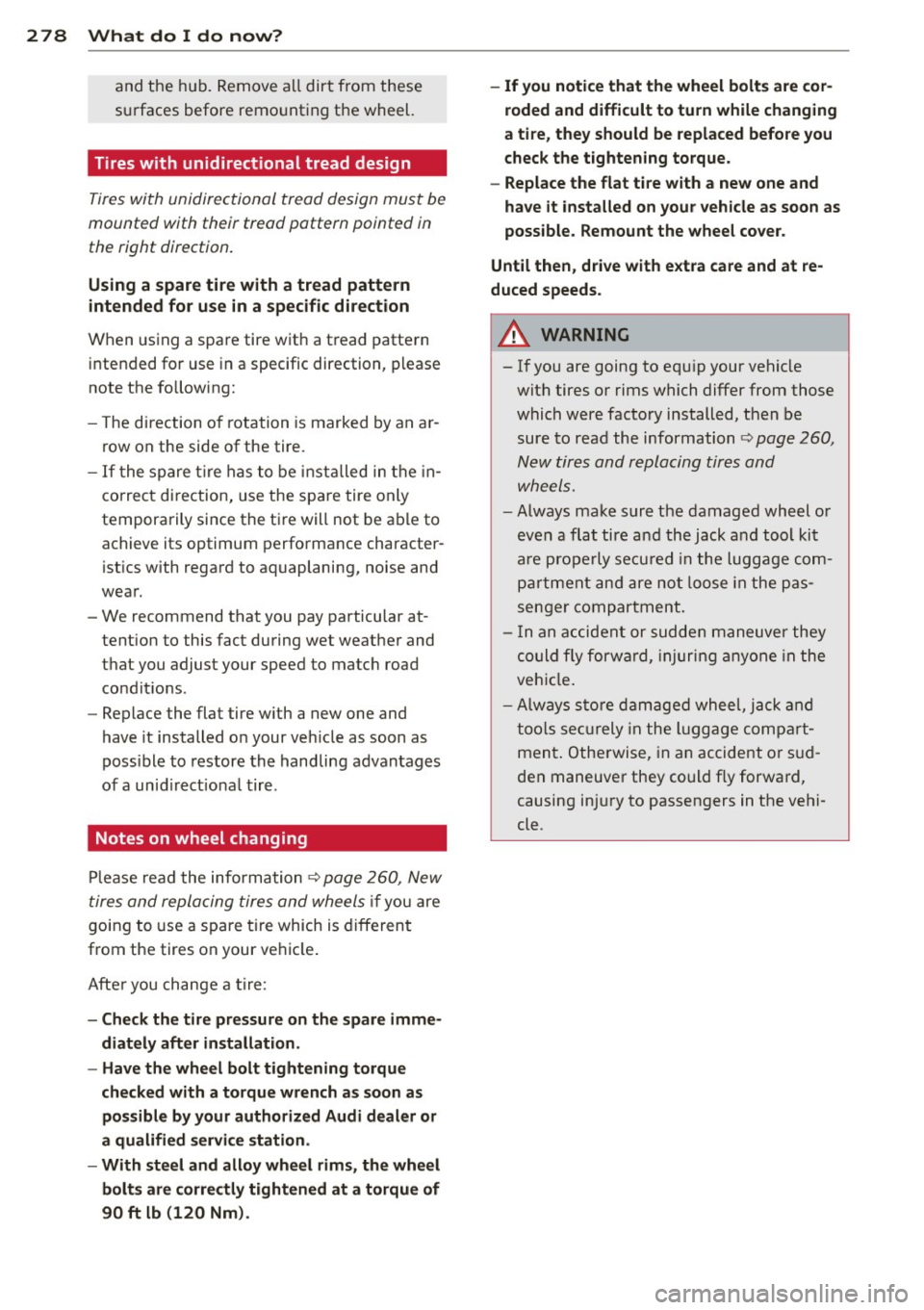
278 What do I do now?
and the hub. R emove a ll dirt from these
su rfaces before remo unt ing the wheel.
Tires with unidirectional tread design
Tires with unidirectional tread design must be
mounted with their tread pattern pointed in
the right direction .
Using a spare tire with a tread pattern
intended for use in a specific direction
When using a spa re tire with a t read patte rn
i n te nded fo r use in a specific direction, please
note the fo llowing:
- T he direction o f rotation is marked by a n ar
row on the side of the tire.
- If the spare t ire has to be in stalled i n the in
corre ct d irection, use the sp are tire on ly
temporarily since the t ire will not be a ble to
achieve its optimum perfo rmance character
ist ics with rega rd t o aquaplaning, noise and
wea r.
- We recommend t hat you pay pa rticular at
tent ion to this fact during wet weat her and
t h at y ou adjust your speed to matc h road
condit ions .
- Replace the flat tire w ith a new one and
have it installed o n your ve hicle as soon as
poss ible to restore th e handli ng a dvantages
of a un id irect iona l tir e.
Notes on wheel changing
Pl ease re ad the informa tion i:> page 260, New
t ires and repl acing tires and wheels
if you are
goin g to use a spare tire which is differen t
from the tires on your ve hicle.
Afte r you cha nge a tire :
-Check the t ire pressure on the spare imme
diately after installation .
- Have the wheel bolt tightening torque
checked with a torque wrench as soon as
possible by your authorized Audi dealer or
a qualified service station .
- With steel and alloy wheel rims, the wheel
bolts are correctly tightened at a torque of
90 ft lb (120 Nm) . -
If you notice that the wheel bolts are cor
roded and difficult to turn while changing
a tire , they should be replaced before you
check the tightening torque.
- Replace the flat tire with a new one and
have it installed on your vehicle as soon as
possible. Remount the wheel cover .
Until then , drive with extra care and at re
duced speeds.
A WARNING
- I f you are going to eq uip your vehicle
wit h tires or rims which differ from those
which were factory installed, then be sur e to r ead the information
i:> page 260,
New tir es and replacing tir es and
wheels.
- Always ma ke sure th e damag ed wh eel o r
e v en a flat tir e and th e jack a nd tool ki t
a re pr operly se cu red in the lugga ge co m
p art me nt a nd a re not l oo se in the pas
sen ger com partment .
- I n an a ccide nt or sudde n maneuver they
could fly forward, injuring anyone in the
veh icle.
- Always store dama ged whee l, j ac k and
t oo ls se curely in the l ugg age c omp art
men t. Otherwise, in an acci dent o r sud
de n maneuve r they could fly forwa rd,
causing inj ury to passen gers in the vehi
cle.
Page 281 of 318
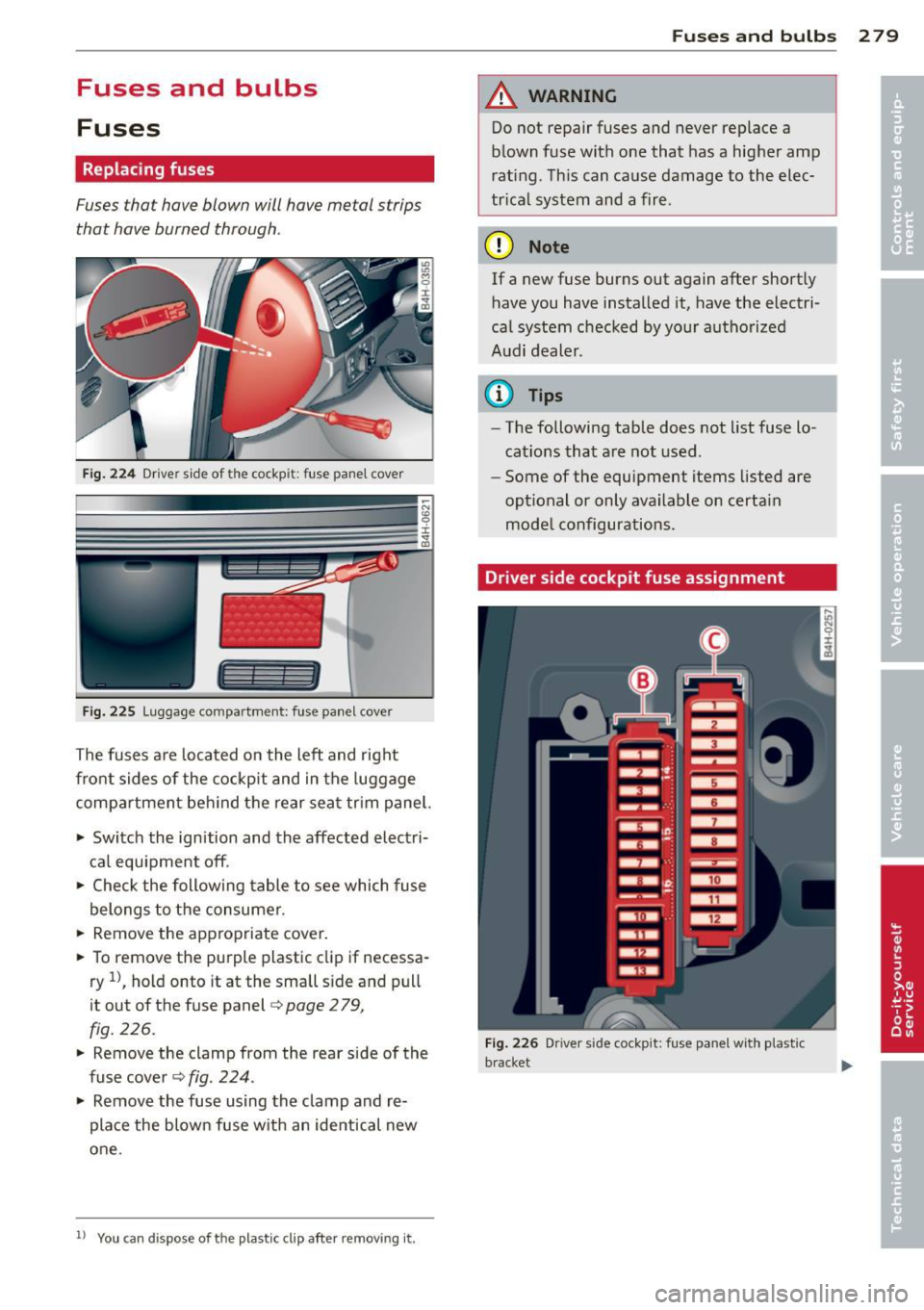
Fuses and bulbs
Fuses
Replacing fuses
Fuses that have blown will have metal strips
that have burned through.
Fig . 22 4 Driver side of the cockp it: fuse panel cove r
~~
-----~ ~~
Fig. 225 Luggage compartme nt: fuse pa nel cover
The fuses a re located on the left and right
front sides of the cockp it and in the luggage
comp artment be hind the rear seat tr im pane l.
.. Switch the ignition and the affected electri-
ca l equipment off .
.. Check the following table to see which fuse
belongs to the consume r .
.. Remove the appropriate cover .
.. To remove the purple plastic clip if necessa
ry
1l, hold onto it at the small side and pull
it out of the fuse panel
c:> page 2 79,
fig. 226.
.. Remove the clamp from the rear side of the
fuse cover
c:> fig . 224 .
.. Remove the fuse using the clamp and re
pla ce the blown fuse w ith an identical new
one.
11 You can dis pose of the pla st ic cl ip after remov ing it.
Fu se s and bulb s 2 79
A WARNING
Do not repair fuses and never replace a
blown fuse with one that has a hig her amp
rating . Th is can ca use damage to the elec
tr ical system and a fir e.
(D Note
If a new fuse burns out again after short ly
have you have insta lled it, have the electri
ca l system checked by yo ur autho rized
Audi dealer.
{i) Tips
- The followi ng table does not list fuse lo
cat io ns that a re not used .
- Some of the equipment items listed are
opt ional or only available on certa in
model configurations.
Driver side cockpit fuse assignment
F ig . 2 26 Dr iver side cockp it: fuse pane l w ith plast ic
b racket
Page 285 of 318
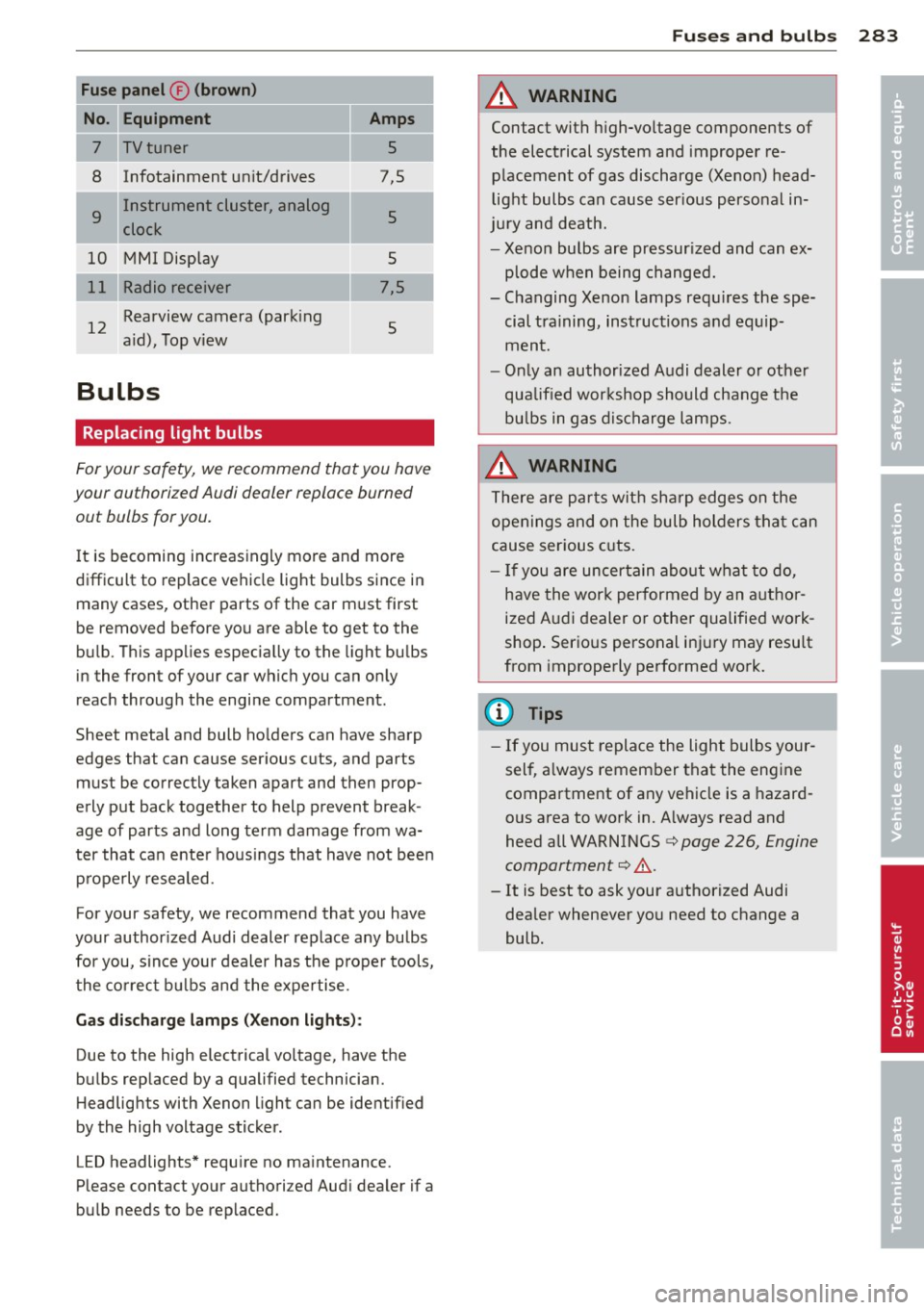
Fuse panel® (brown)
No. Equipment Amps
= ' =
7 TV tuner 5
8 Infotainment unit/drives 7,5
9
Instrument cluster, analog
5 clock
10 MMI Display 5
11 Radio receiver 7,5
12
Rearview camera (park ing
5 a id) , Top v iew
Bulbs
Replacing light bulbs
For your safety, we recommend that you hav e
your authorized Audi dealer replace burned out bulbs for you.
It is becoming increasingly more and more
difficu lt to replace vehicle light bulbs since in
many cases, other parts of the car must first
be removed before you are able to get to the
bulb . This applies especially to the light bulbs
in the front of your car which you can only
reach through the engine compartment.
Sheet metal and bulb ho lders can have sharp
edges that can cause serious cuts, and parts must be correctly taken apart and then prop
erly put back together to help prevent break
age of parts and long term damage from wa
ter that can enter housings that have not been
properly resealed .
For your safety, we recommend that you have
your author ized Audi dealer replace any bulbs
for you, since your dealer has the proper tools,
the correct bulbs and the expertise.
Gas discharge lamps (Xenon lights):
Due to the high electrical voltage, have the
bulbs replaced by a qualified technician.
Headlights with Xenon light can be identified
by the high voltage sticker .
LED headlights* requ ire no ma intenance .
Please contact your authori zed Audi dealer if a
bulb needs to be replaced.
Fuses and bulbs
A WARNING
Contact with high-voltage components of
the electrical system and improper re
placement of gas discharge (Xenon) head
light bulbs can cause ser ious personal in
jury and death.
- Xenon bulbs are pressur ized and can ex
plode when being changed.
- Changing Xenon lamps requ ires the spe
cial tra ining, instructions and equip
ment.
- Only an authorized Audi dealer or other
qua lified workshop should change the
bu lbs in gas discharge lamps .
A WARNING
There are parts with sharp edges on the
openings and on the bulb holders that can
cause serious cuts.
- If you are uncertain about what to do,
have the work performed by an author
ized Audi dealer or other qualified work
shop . Serious personal inj ury may result
from improperly performed work.
(D Tips
-If you must replace the light bulbs your
sel f, a lways remember that the engine
compartment of any vehicle is a hazard
ous area to work in. A lways read and
heed all WARNINGS
<=> page 226, Engine
compartment<=> ,&..
- It is best to ask your authorized Audi
dealer whenever you need to change a
bulb.
-
283
•
•
Page 286 of 318

284 Emergency situations
Emergency situations
General
This chapter is intended for trained emer
gency crews and working personnel who
have the necessary tools and equipment to
perform these ope rations.
Starting by pushing or
towing
Q;) Note
Vehicles w ith an automatic transmission
cannot be started by pus hing o r tow ing.
Starting with jumper
cables
If necessary, the engine can be started by
connecting it to the battery of another vehi
cle.
If the engine should fail to start because of a
discharged or weak battery, the battery can be
connected to the battery of
another vehicle,
using a
pair of jumpe r cables to start the en
g ine .
Jumper cables
Use only jumper cables of sufficiently large
cross section to carry the starter current safe
ly. Refer to the manufacturer's specif ications.
Use only jumper cables with
insulated termi
na l clamps which are distinctly marked:
plus(+) cable in most cases colored red
minu s(-) cable
in most cases colored black .
A WARNING
Batteries contain electricity, acid, and gas.
Any of these can cause very serious or fatal
inju ry. Follow the instructions below for
safe handling of your veh icle's battery.
- Always shield you r eyes and avoid lean
ing over the battery whenever possible.
- A discharged battery can freeze at tem
peratures just be low 32 °F (0 °C). Before connecting a
jumper cable, you must
thaw the frozen battery complete ly, oth
erwise it could explode.
- Do not allow battery acid to contact eyes
or skin . Flush any contacted area with
water immediately .
- Improper use of a booster battery to start a vehicle may cause an explosion.
- Vehicle batteries generate explosive gas
es. Keep sparks, flame and lighted ciga
rettes away from batteries.
- Do not try to jump start any vehicle with a low acid level in the battery.
- The vo ltage of the booster battery must
also have a 12-Volt rating. The capacity
(Ah) of the booster battery should not be
lower than that of the discharged bat
tery . Use of batteries of d ifferent voltage
or substantially different "Ah" rating
may cause an exp losion and personal in
jury.
- Never charge a frozen batte ry. Gas trap
ped in the ice may cause an explosion.
- Never charge or use a battery that has
been frozen. The battery case may have
be weakened.
- Use of batter ies of different voltage or
substantially different capacity (Ah) rat
ing may cause an exp losion and injury.
The capacity (Ah) of the booster battery
should not be lower than that of the dis
charged battery.
- Before you check anything in the engine
compartment, always read and heed a ll
WARNINGS¢
page 226 , Engine com
partment.
«I) Note
-Applying a higher voltage booster bat
tery will cause expensive damage to sen
sitive electronic components, such as
contro l units, relays, rad io, etc .
- There must be no electrical contact be
tween the vehicles as otherwise current
could already start to flow as soon as the
positive(+) terminals are connected. ..,_
Page 287 of 318
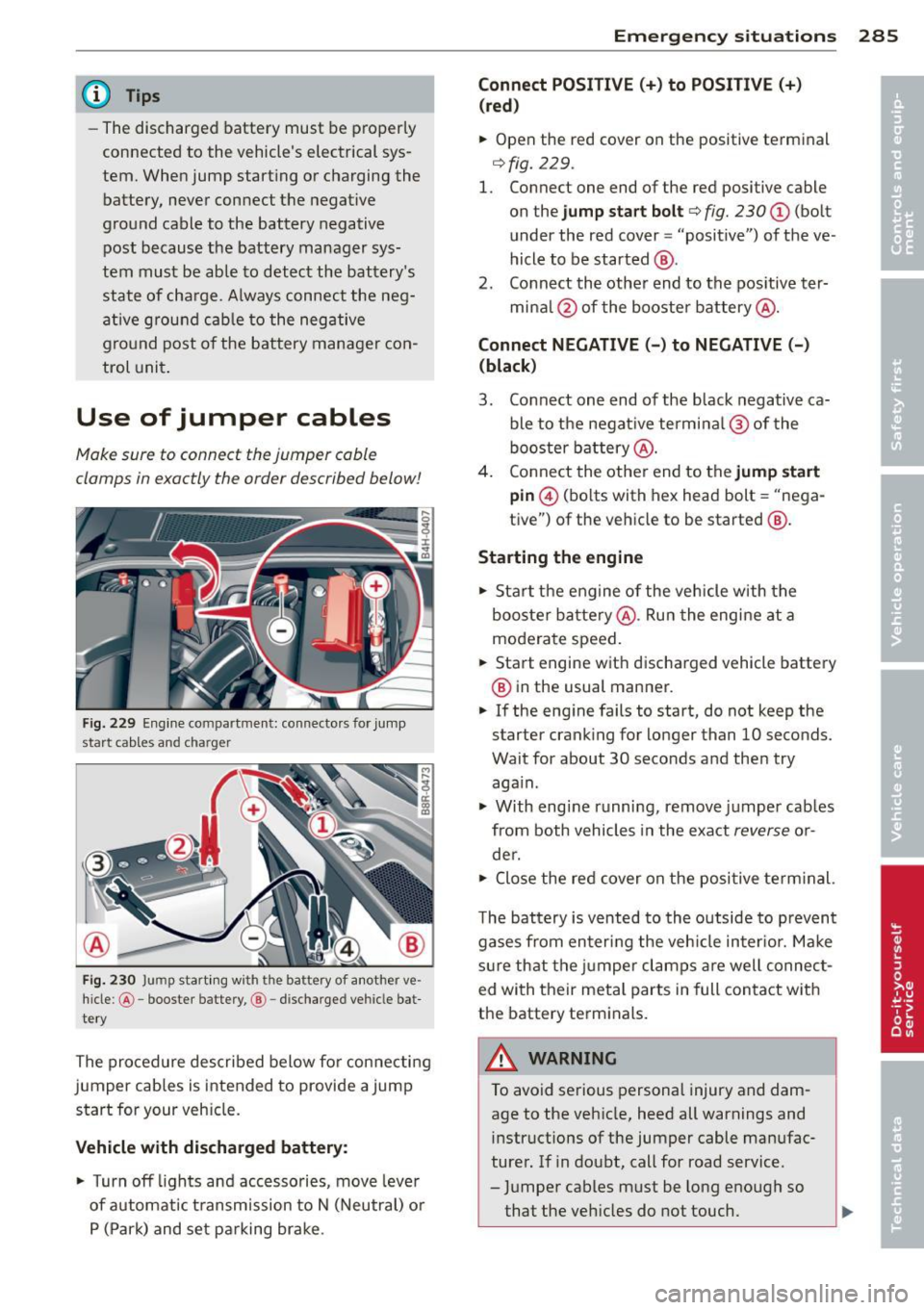
@ Tips
- The discharged battery must be properly
connected to the vehicle's electrical sys
tem. When jump start ing or charging the
battery, never connect the negative
ground cable to the battery negative post because the battery manager sys
tem must be able to detect the battery's
state of cha rge. A lways connect the neg
ative g round cab le to the negative
gro und post o f the battery manage r con
trol uni t.
Use of jumper cables
Make sure to connect the jumper coble
clomps in exactly the order described below!
Fig. 229 Engine compartment: connecto rs for jump
start cables and charger
Fi g. 230 Jump start ing w ith the battery of another ve
hicle: @-booste r batte ry, @ -discharged vehicle bat
te ry
The procedure described below fo r connecting
jumper cab les is intended to provide a jump
start for your veh icle.
Vehicle with discharged batt ery:
.. Turn off lights and acc esso ries, move leve r
of automat ic t ransm ission to N (Neutral) o r
P (Park) and set pa rking brake .
Emergenc y situ ation s 285
Connect POSI TIVE(+) to POSITIVE (+ )
(red )
.. Open the red cover on the positive terminal
¢fig. 229.
1. Connect one end of the red positive cable
on the
jump sta rt bolt ¢ fig. 230 (D (bolt
under the red cover = "positive") of the ve
hicle to be started @.
2. Co nnect th e other end to the pos itive ter-
mina l@ of the booster battery @.
Connect NEGATIVE( -) to NEGATIVE(-)
(black )
3. Connect one end of the black negative ca ble to the negat ive termina l@ of the
booster b attery @.
4 . Connect the othe r end to the
jump start
pin @ (bolts with hex head bolt = "nega
tive") of the vehicle to be started @.
Starting the engine .. Sta rt the engine of the veh icle w ith the
booste r ba ttery @. Ru n the engine at a
moderate speed .
.. Start engine wit h discha rged vehicle battery
@ in the usual manner .
.. If the eng ine fails to start, do not keep the
starter cranking for longer than 10 seconds.
Wait for about 30 seco nds a nd the n try
aga in .
.. With engi ne runni ng, remove j umper cab les
from both vehicles in the exact
reverse o r
de r .
.. Close the red cover on the positive term inal.
T he battery is vented to th e outside to p rev ent
gases from en ter ing the veh icle in ter io r. Ma ke
s ur e th at the j umper clamps are well connec t
ed with their meta l parts in full con ta ct w ith
the battery term inals.
A WARNING
To avoid se rious personal injury and dam
age to the veh icle, heed all warnings and
instructions of the jumper cable man ufac
turer. If in doubt, call for road service .
- J umper cables m ust be long enough so
that the veh icles d o not touch.
-
Page 288 of 318
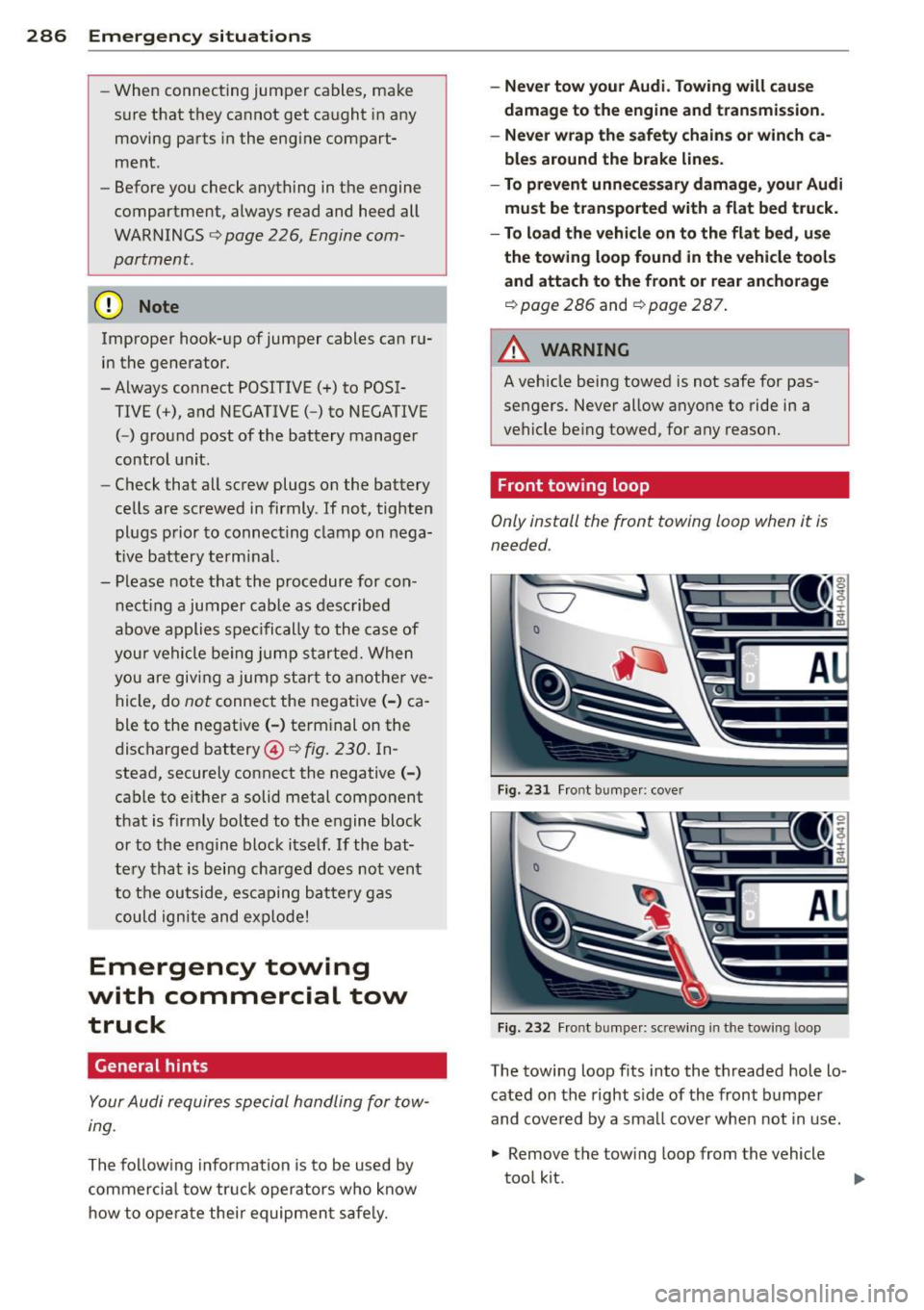
286 Emergency situations
-When connecting jumper cables, make
sure that they cannot get caught in any
moving parts in the engine compar t
ment .
- Before you check anything in the engine
compartment, always read and heed all
WARNINGS
c:> page 226 , Engine com
partment.
(D Note
Improper hook-up of jumper cables can ru
in the generator.
- Always connect POSITIVE(+) to POSI
TIVE( +), and NEGATIVE( -) to NEGATIVE
( - ) ground post of the battery manager
control unit.
- Check that all screw plugs on the battery
cells are screwed in firmly . If not, tighten
plugs prior to connecting clamp on nega
tive battery terminal.
- Please note that the procedure for con
necting a jumper cable as described
above applies specifically to the case of
your vehicle being jump started. When
you are giving a jump start to another ve
hicle, do
not connect the negative(-) ca
ble to the negative(-) terminal on the
discharged battery ©
c:> fig. 230. In
stead, securely connect the negative(-)
cable to either a solid metal component
that is firmly bolted to the engine block
or to the engine block itself . If the bat
tery that is being charged does not vent
to the outside, escaping battery gas
could ignite and explode!
Emergency towing
with commercial tow
truck
General hints
Your Audi requires special handling for tow
tng.
The following information is to be used by
commercial tow truck operators who know
how to operate their equipment safely.
-Never tow your Audi. Towing will cause
damage to the engine and transmission.
- Never wrap the safety chains or winch ca
bles around the brake lines.
- To prevent unnecessary damage, your Audi
must be transported with a flat bed truck.
- To load the vehicle on to the flat bed, use
the towing loop found in the vehicle tools
and attach to the front or rear anchorage
c:> pag e 286 and c:> page 287.
.&_ WARNING
=
A vehicle being towed is not safe for pas-
sengers. Never allow anyone to ride in a
vehicle being towed, for any reason.
Front towing loop
Only install the front towing loop when it is
needed .
C7
0
Fig. 231 Front bumper: cover
Fig. 232 Front bumper : sc rewing in th e towin g loop
-
The towing loop fits into the threaded hole lo
cated on the right side of the front bumper
and covered by a small cover when not in use.
.,. Remove the towing loop from the veh icle
tool kit.
Page 289 of 318
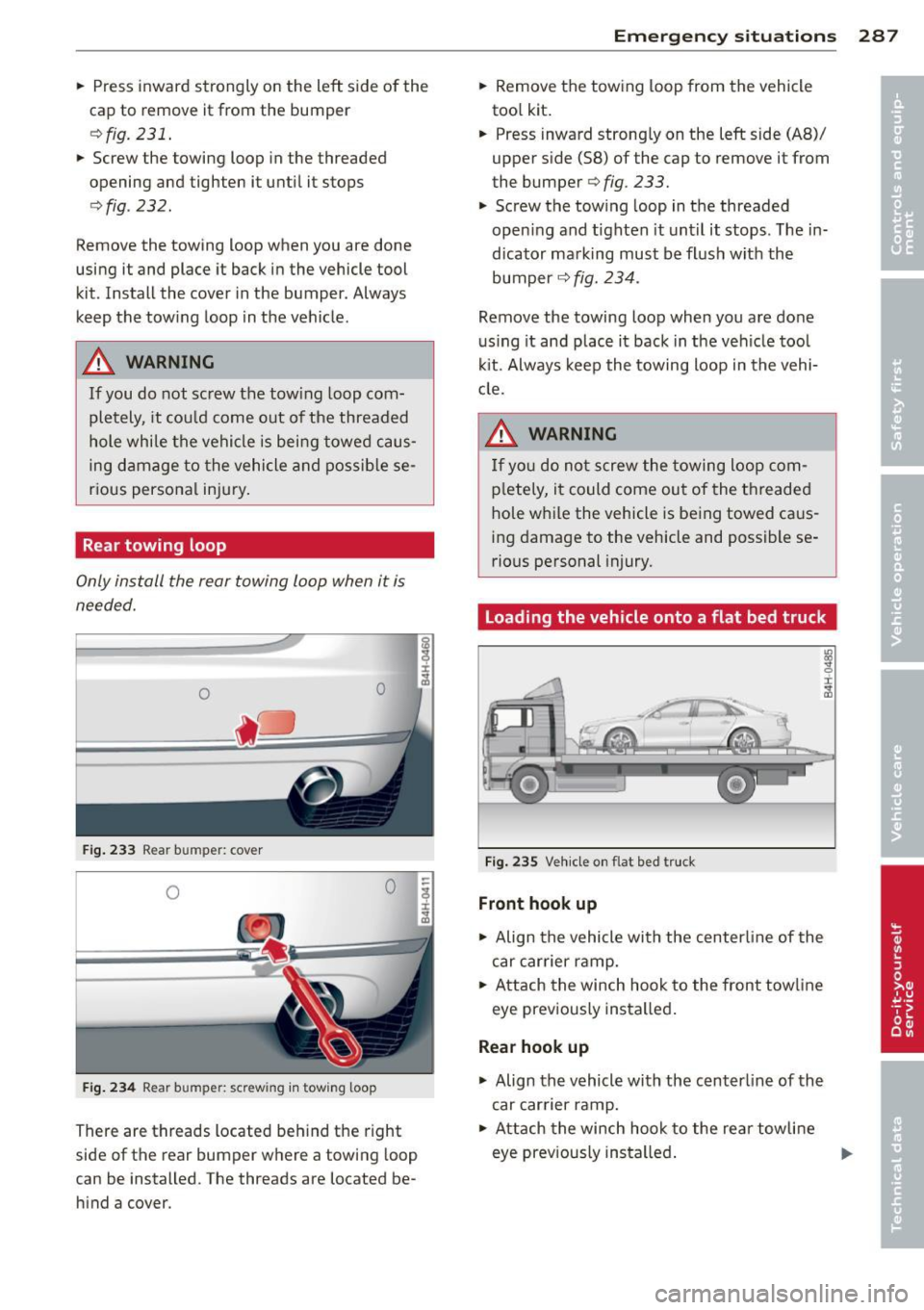
.. Press in ward strongly on the left side of the
cap to remove it from the bumper
e::>fig . 231 .
.. Screw the towing loop in the threaded
opening and tighten it until it stops
e::> fig . 232 .
Remove the towing loop when you are done
using it and place it back in the vehicle tool
kit. Install the cover in the bumper. Always
keep the towing loop in the vehicle .
..&_ WARNING
If you do not sc rew the tow ing loop com
pletely, it cou ld come out of the threaded
hole while the vehicle is bei ng towed caus
ing damage to the vehicle and possib le se
r ious perso nal injury .
Rear towing loop
Only install the rear towing loop when it is
needed.
0 0
Fig . 233 Rear bumper: cover
0 0
Fig. 2 34 Rear bumper : screw ing in towing loop
There are threads located be hind the right
side of the rear bumper w here a towing loop
can be installed. The threads are located be
hind a cover.
-
Emergenc y situ ation s 287
.. Remove the tow ing loop from the vehicle
too l kit .
.. Press inward strongly on the left side (AB)/
upper s ide (58) of the cap to remove it from
the bumper
e::>fig. 233.
.. Screw the towing loop in the threaded
open ing and t ighten it unt il it stops. The in
dicator ma rking must be f lush with the
bumper
e::> fig. 234 .
Remove the towing loop when you are done
using it and plac e it back in the ve hicle too l
ki t. Always keep the towing loop in the vehi
cle.
..&_ WARNING
If yo u do not screw the towing loop com
p letely, i t could come ou t of the t hreaded
hole while the vehicle is be ing towed caus
ing damage to the vehicle and possible se
rious pe rsonal injury.
loading the vehicle onto a flat bed truck
Fi g. 235 Vehicle on flat bed tru ck
Front hook up
.. Align the vehicle wi th the centerline of the
car car rier ramp .
.,. Attach the winch hook to the front tow line
eye prev iously insta lled .
Rear hook up
.,. Align the vehicle with the c enter line of the
car earner ramp .
.. Att ach the winch hook to the re ar towli ne
eye prev ious ly insta lled .
Page 290 of 318
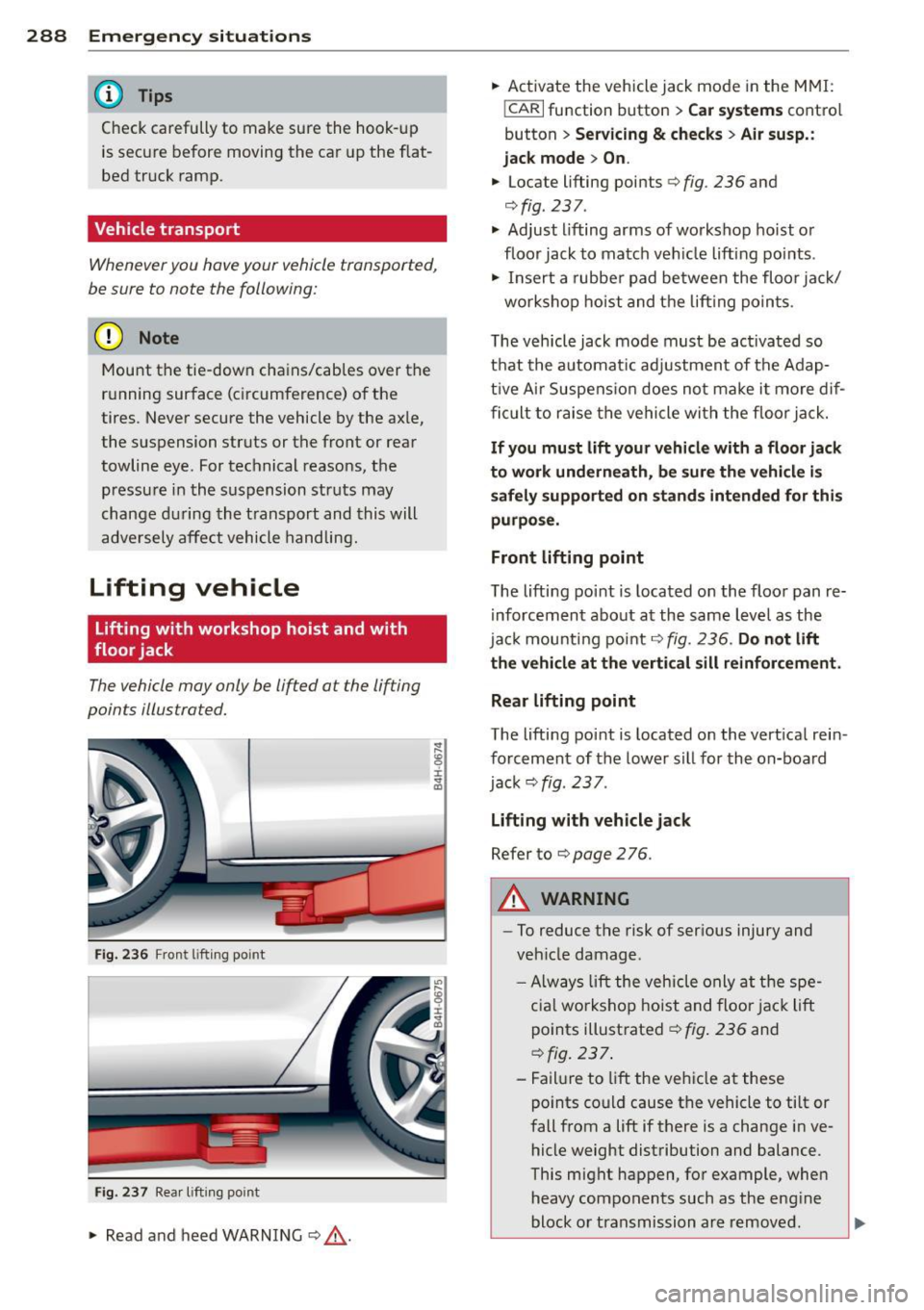
288 Emergency situations
@ Tips
Check carefully to make sure the hook- up
is secure before moving the car up the flat
bed truck ramp.
Vehicle transport
Whenever you have your vehicle transported ,
be sure to note the following:
(D Note
Mou nt the tie-down cha ins/cab les over the
r u nning surface (c ircumference) of the
tires. Never secure the vehicle by the ax le,
the suspension struts or the front or rear
towline eye . For technical reaso ns, the
pressure i n the suspension struts may
change during the t ransport and this will
adve rsely affe ct vehicle handling.
Lifting vehicle
Lifting with workshop hoist and with
floor jack
The vehicle may only be lifted at the lif ting
poin ts illustra ted.
F ig . 23 6 Fro nt lift in g po int
Fi g. 237 Rea r lift in g point
.,. Read and heed WARNING ¢ _& .
.,. Ac tivate the vehicle jack mode in the M MI:
!CARI fu nction button > Car systems cont ro l
button
> Servicing & checks > Air susp. :
jack mode
> On .
.,. Locate lifting poi nts ¢ fig . 236 and
¢fig . 237 .
.,. Adjust lifting arms of worksho p hoist o r
floo r jack to match ve hicle lift ing poi nts .
.,. In sert a rubbe r pad be tween the floo r ja ck/
w or ksho p hoist and t he lift ing poin ts.
The veh icle jack mode must be ac tiva ted so
t h at the au tomat ic ad justment of the Adap
t ive A ir Suspens io n does not ma ke i t more dif
ficu lt to raise t he vehicle wit h the floor ja ck.
If you must lift your veh icle with a floor jack
to work underneath, be sure the vehicle is
safel y supported on stand s intended for thi s
purpo se.
Front lifting point
T he lifti ng poi nt is located o n the floor pan re
i nforcement abo ut at the same l eve l as the
ja ck mount ing poi nt
¢ fig . 236 . Do not lift
the vehicle at the verti cal sill reinforcement.
Rear lifting point
The lifting po int is located on the vert ica l rein
fo rcement of the lower s ill for the on-boa rd
jack
¢ fig . 237 .
Lifting with vehicle jack
Refer to ¢page 276.
A WARNING ,= -
-To reduce the risk of ser ious injury and
veh icle damage .
- Alw ays li ft the vehicle o nly at the spe
c ia l workshop hoist and floor jac k lift
points illustrated
¢ fig. 236 and
¢fig. 237 .
-Fail ure to lift the ve hicl e at these
po ints co uld cause the vehicle to tilt or
fall from a lift if there is a change i n ve
hicle weight dist ributi on and balance .
This might happen, fo r example, when
heavy components such as the eng ine
block o r transmission a re remove d .
Page 292 of 318
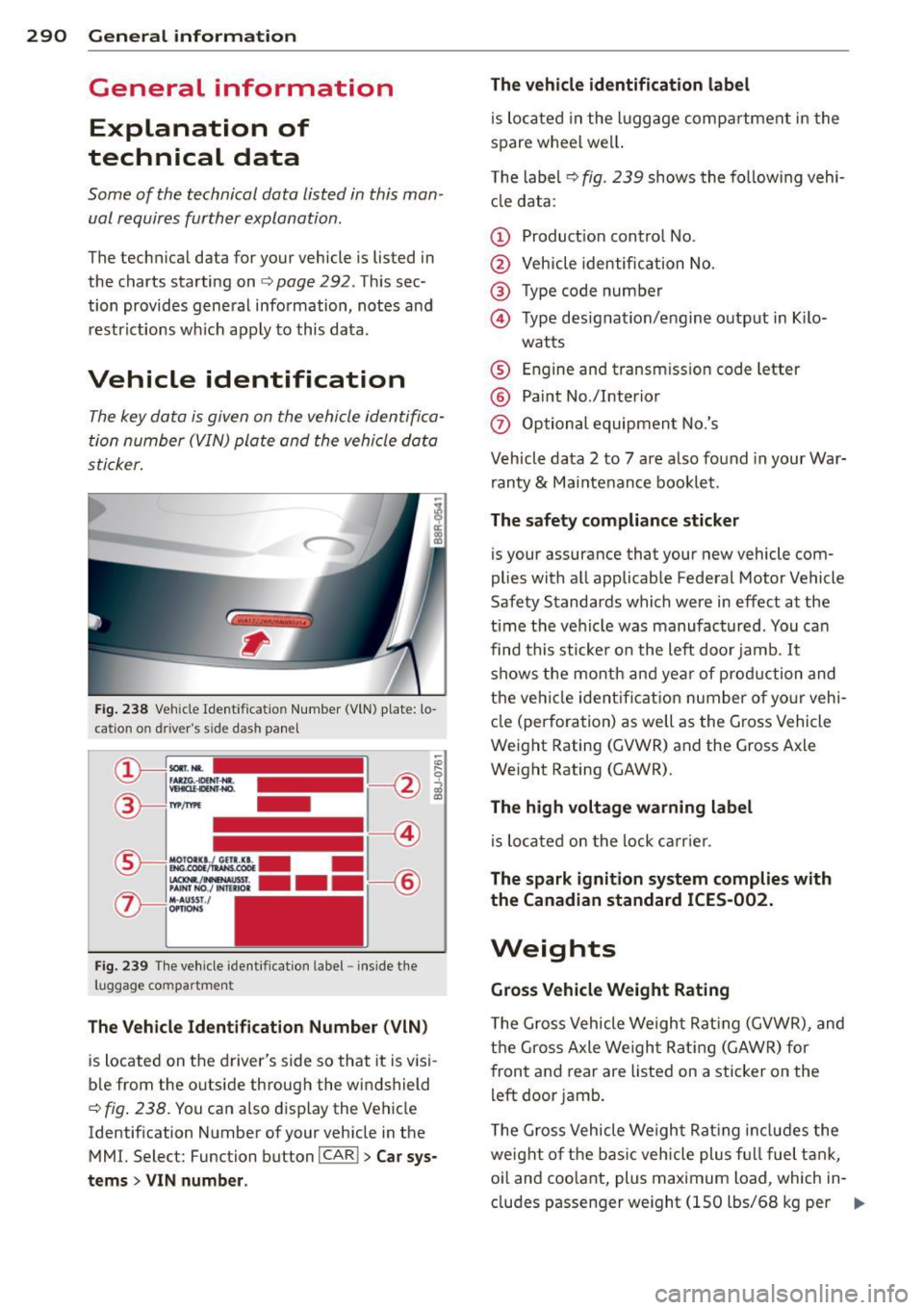
2 90 General information
General information Explanation of
technical data
Some of the technical data listed in this man
ual requires further explanation .
The technical data for your vehicle is listed in
the charts starting on
r:::> page 292. This sec ·
tion provides general information, notes and restrictions which apply to this data .
Vehicle identification
The key data is given on the vehicle identifica·
tion number (VIN) plate and the vehicle data
sticker.
Fig. 238 Veh icle Ide ntific atio n Number (VlN) p late: lo
cation on driver 's sid e das h panel
Fig. 239 The vehicle identi fication label -inside the
luggage co mpa rtmen t
The Vehicle Identification Number (VIN)
is located on the driver's side so that it is visi
b le from the outside through the windshield
r:::> fig . 238. You can also display the Vehicle
Identification Number of your vehicle in the
MMI. Select: Function button
ICAR ! > Car sys
tems
> VIN number . The
vehicle identification label
is located in the luggage compartment in the
spare wheel wel l.
The label¢
fig. 239 shows the following vehi
cle data :
(D Production control No .
@ Vehicle identification No.
® Type code number
@ Type designation/engine output in Kilo·
watts
® Engine and transmission code letter
@ Paint No./Interior
(f) Optional equipment No.'s
Vehicle data 2 to 7 are also found in your War·
ranty
& Maintenance booklet.
The safety compliance sticker
is you r assurance that your new vehicle com
plies with all applicable Federal Motor Vehicle
Safety Standards which were in effect at the
time the vehicle was manufactured . You can
find this sticker on the left door jamb.
It
shows the month and year of production and
the ve hicle ident ification number of your vehi ·
cle (perforation) as well as the Gross Vehicle
Weight Rating (GVWR) and the Gross Axle
Weight Rating (GAWR) .
The high voltage warning label
is located on the lock carr ier .
The spark ignition system complies with
the Canadian standard ICES-002.
Weights
Gross Vehicle Weight Rating
The Gross Vehicle Weight Rating (GVWR), and
the Gross Axle Weight Rating (GAWR) for
front and rear are Listed on a sticker on the
left door jamb.
The Gross Vehicle Weight Rating includes the
weight of the basic vehicle plus full fuel tank,
oi l and coolant, plus maximum load, wh ich in·
eludes passenger weight (lSO lbs/68 kg per
Ill>